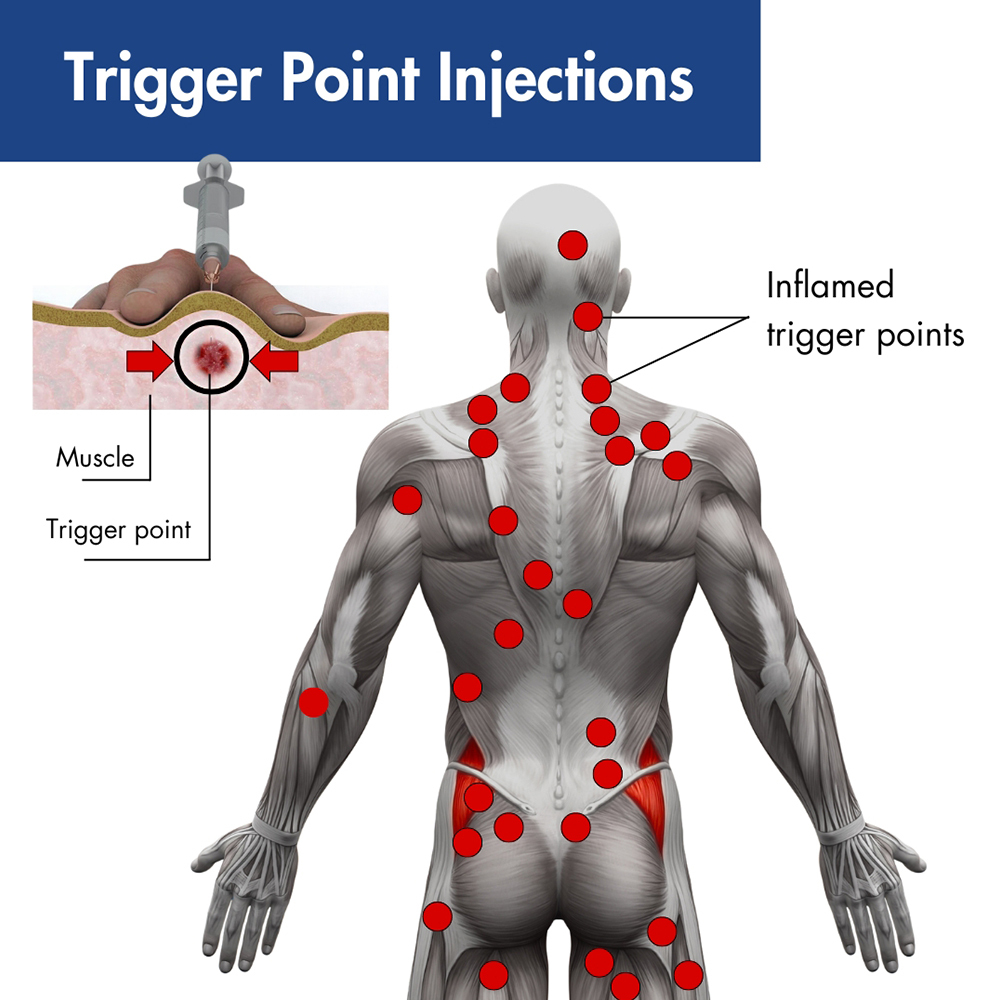We’re pleased to announce that Pain Physicians of Wisconsin is now Pro Spine Pain.
We’re pleased to announce that Pain Physicians of Wisconsin is now Pro Spine Pain.
 If you’ve been experiencing debilitating myofascial pain in your neck, shoulder, legs, arms, or lower back, then you may need a trigger point injection to alleviate it. The name comes from the term “trigger points,” which are also known as knots that you may find in your muscles when they’re unable to relax.
If you’ve been experiencing debilitating myofascial pain in your neck, shoulder, legs, arms, or lower back, then you may need a trigger point injection to alleviate it. The name comes from the term “trigger points,” which are also known as knots that you may find in your muscles when they’re unable to relax.
Most likely, if you have knots, you will be able to feel trigger points in your skin. Often they’re
sensitive to touch due to the irritation they cause to the surrounding nerves. You may also experience referred pain, which causes you to experience pain in another part of the body.
Often, trigger points arise following stress on the muscle fibers from acute trauma or repetitive microtrauma. When this happens, muscle fibers stay contracted, being unable to relax, restricting movement and significantly impacting the quality of your life.
One option that can provide permanent or temporary relief from these knots is trigger point injections. These injections are a minimally invasive procedure that takes around 30 minutes to administer.
When this injection is given, you’ll be administered a local anesthetic or saline to feel no pain alongside a corticosteroid to soothe the muscle, spasms, and inflamed tissues. You’ll likely feel the benefits of this injection within 24-72 hours.
Trigger point injections are used to treat a range of conditions and symptoms that are linked to muscle pain and knots. Often, trigger point injections are one part of a multiple treatment plan. These injections might be included in a plan to treat:
Symptoms:
Conditions:
Out of all of these, one of the most common conditions trigger point injections are given is to treat myofascial pain, which affects around 9 million people in the USA. This is a regional muscle pain that develops only due to the formation of trigger points.
If you experience any of these conditions or symptoms, book an appointment with one of our physicians. With five centrally located state-of-the-art clinics in Wisconsin, you can safely recommend the right treatment depending on your diagnosis, type of pain, medical history, and lifestyle.
While trigger points can arise in any muscle, the main muscle groups trigger point injections can treat are:
In the TPI procedure, a health care professional inserts a small needle into the patient’s trigger point. The injection contains a local anesthetic or saline, and may include a corticosteroid. With the injection, the trigger point is made inactive and the pain is alleviated. Often, a brief course of treatment will result in sustained relief. Injections are given in a doctor’s office and usually take just a few minutes. Several sites may be injected in one visit. If a patient has an allergy to a certain drug, a dry-needle technique (involving no medications) can be used.
Before being given a trigger point injection, you must have a consultation with one of our physicians first. In this appointment, they’ll review your pain and medical history, alongside any symptoms and concerns you have.
They may even refer you for physical therapy or imaging tests to pinpoint the exact location of your trigger point. Moreover, if you take certain medications like blood thinners, they might advise you to stop beforehand.
Then, on the day of the procedure, they will:
It’s normal to experience a little pain after trigger point injections during the first couple of days. You will likely be advised to avoid strenuous activities or vigorous exercise for the affection to take effect.
At Pro Spine & Pain, our team of specialist physicians, with a focus on anesthesiology and pain management, regularly give trigger point injections to their patients. With extensive clinical experience and advanced techniques, they’re your go-to experts for treating and solving complex and acute spinal pain. Book an appointment with Pro Spine & Pain to see how their diagnosis, advice, and treatments can transform the quality of your life.
Often, a trigger point injection can provide pain relief for up to a month. If, after a month, you still find yourself experiencing severe pain, you may be referred for additional injections or treatments to deal with your pain.
Often, trigger point injections can help treat tension headaches or migraine. They can provide immediate relief for head issues.
There are three main types of trigger points, which are active, passive, and satellite. Active are painful when you touch them and send pain to other areas of your body. Meanwhile, passive and satellite are not as painful.

Thomas Stauss, MD, completed both his undergraduate and medical studies at the esteemed University of Wisconsin in Madison. Dr. Stauss values having access to a wide array of cutting-edge treatment options, ensuring effective relief for his patients' discomfort and a significant enhancement in their quality of life. More specifically, he specializes in utilizing implanted devices to manage chronic pain. Dr. Stauss’s primary objective is to uphold the dignity of each patient while delivering ethical and professional services.
More about Dr. Stauss